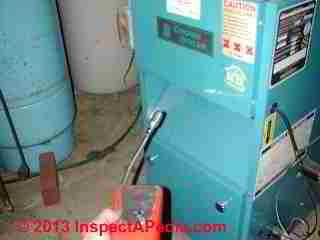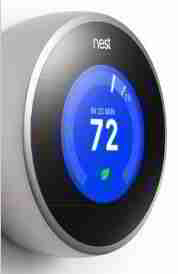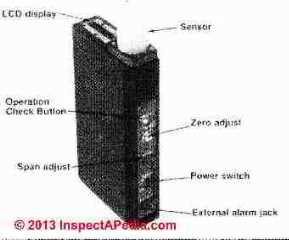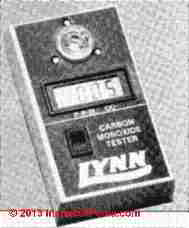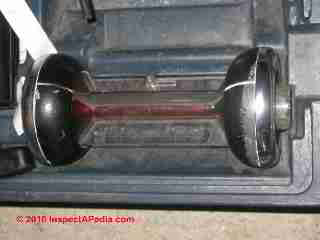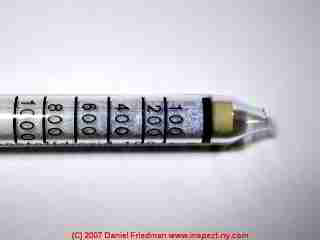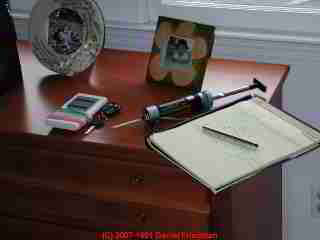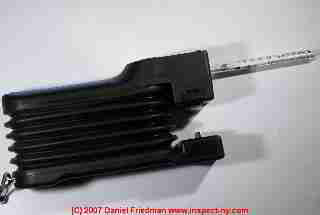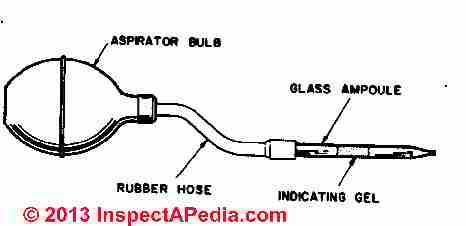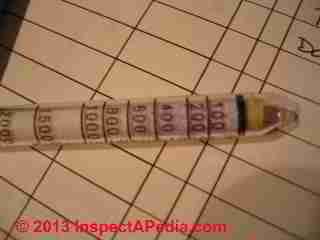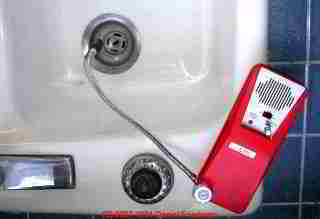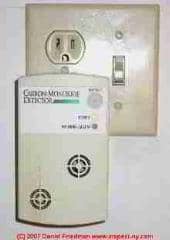 Carbon Monoxide Detection & Testing
Carbon Monoxide Detection & Testing
- POST a QUESTION or COMMENT about choosing a portable CO detector for field use
Carbon monoxide testing: this article suggests methods for testing for carbon monoxide in buildings and describes different types of portable carbon monoxide detection instruments or tools and how they may be used to screen for CO leakage or CO hazards.
Choosing and Using a CO Detector or CO Monitor for Carbon Monoxide. CO Gas Testing Procedures, Tools, Devices.
We also discuss the limitations of relying on any sort of instrumentation indoors to screen for dangerous CO leakage and the importance of visual inspection and recording of complaint history as well. When in doubt, get out.
InspectAPedia tolerates no conflicts of interest. We have no relationship with advertisers, products, or services discussed at this website.
- Daniel Friedman, Publisher/Editor/Author - See WHO ARE WE?
Tools & Equipment for Detection of Carbon Monoxide - CO Gas in buildings
IF YOU SUSPECT CARBON MONOXIDE POISONING GO INTO FRESH AIR IMMEDIATELY and get others out of the building, then call your fire department or emergency services for help. Links on this page also direct the reader to carbon dioxide gas information in a separate document.
Seek prompt advice from your doctor or health/safety experts if you have any reason to be concerned about exposure to toxic gases. Carbon monoxide poisoning can be fatal but exposure at lower limits can produce flu-like symptoms and headaches that are often mistaken for ordinary illness.
In addition to the installation of CO monitoring alarms in buildings, a variety of electronic and gas sampling equipment is available to make spot checks for hazardous gases. I have and have used a variety of these devices under a wide range of conditions.
While a "positive" indication of a gas is an important indicator of a hazard, a "negative" or "not found" result is nothing to rely on.
The fact that dangerous levels of CO are not present in a building at a particular instant is absolutely no guarantee that dangerous levels of CO (for example) may not occur even moments later.
For example, opening a window, turning on a fan or clothes dryer, closing a door, and similar innocent acts can significantly change air flow, combustion air, and other building conditions.
Therefore spot tests for dangerous gases should not be relied upon to guarantee building safety. This is why the list of visual inspection items and proper heating equipment maintenance are so important.
Readers should also be sure to review Heating System Check Recommended for Carbon Monoxide - CPSC Release 88-92
and
our CHIMNEY INSPECTION GUIDE that contains detailed suggestions for inspecting building chimneys including the detection of blocked chimney flues or indications that a chimney may be blocked.
Safety Suggestions: Install Carbon Monoxide Detectors in addition to Smoke Detectors
Carbon monoxide detectors are inexpensive and readily available, both as a battery-operated unit and as a unit that plugs into an electrical outlet in the home.
No home should be without this safety protection, and homes with gas-fired equipment (natural gas or LP propane), space heaters, or other sources of risk should be extra cautious. Smoke detectors do not protect against carbon monoxide poisoning, and the opposite is also true. Carbon monoxide detectors do not warn of smoke or fire.
Carbon Monoxide Alarms & Detectors
 Choosing and Using a CO Detector or Monitor for Heating Appliance Gas Leak Detection
Choosing and Using a CO Detector or Monitor for Heating Appliance Gas Leak Detection
Daniel Friedman
Carbon monoxide alarms (shown at left) or use in buildings to alert residents to unsafe conditions are discussed separately at CO ALARM CAUSES.
These devices are both recommended and in many jurisdictions required in homes and other buildings and are especially critical where fossil-fuel burning appliances such as gas heaters, water heaters, fireplaces and other fossil fuel equipment are used.
At left is a portable plug-in type home carbon monoxide alarm; while this is not a practical CO test instrument for building inspectors in one regard it is a more accurate carbon monoxide safety check in buildings because the device can respond to chronic low-levels of the gas as well as high level surges.
The article below focuses on carbon monoxide detector instruments and methods used to screen buildings where a CO problem might be a worry. This article identifies several devices and methods of CO detection, lists some sources of equipment, and offers sample measurement report text.
Also see Matzen's description of use of calibrated electronic sensors in FURNACES & IAQ. There Mr. Matzen argues vigorously, and we agree, that for common inspection purposes as described in his article, electronic CO monitor sensing devices are the superior tool. However many inspectors and heating professionals use other methods.
Accuracy and cost of these alternatives vary widely, and some very accurate but relatively low-cost alternatives are available. Some of the good, the bad, and the very ugly are discussed in this article.
The Protect® CO & Smoke Detector & Alarm from Nest®
Photot: The Protect®, the new Nest® carbon monoxide & smoke detector on display at a Home Depot store ($129. U.S. in November 2013). The Nest Protect LED ring, shown at left in its blue phase, changes color among blue, green, yellow or red in response to increasing levels of smoke or CO.
In contrast with conventional CO or smoke detectors used in homes, a chime and voice alert also respond at varying levels and volumes.
The Protect® uses wireless communication to a home network to pair with an Apple or Android device to permit setup, control, and emergency notification.It also can communicate with the Nest learning thermostat to incorporate building occupancy patterns and data into its behavior.
See THERMOSTATS, HEATING / COOLING
Nest Smoke Detector Update:
In April 2014 the New York Times reported that Nest Labs was halting sale of the Nest Smoke & CO Detector because of a safety concern: the Nest, programmed to be conveniently silenced during a "false alarm" by the consumer waving her or his hands in front of the device, could inadvertently also be de-activated by other motions by room occupants, possibly delaying the device's response to a real fire or carbon monoxide hazard.
The Times indicated that no instances of this failure had been reported to Next Labs. But this particular feature (hand-waving) was being deactivated by the company who can do so by remote control. - The New York Times, 4/4/14
CO or smoke detector testing and certainly using instruments to screen buildings for carbon monoxide are quite beyond the required scope of home inspections.
While professional inspectors do make these tests, the choice to make CO measurements and the selection of equipment and methodology are not decisions to be made lightly - a mistake could mean someone's death. Regardless of disclaimers of scope and responsibility, the actions and written report of the last building professional to enter a building before an accident or death will be exposed to careful scrutiny.
Neither ASHI, the American Society of Home Inspectors, nor the authors can control the selection and use of test equipment in the field. Readers who address these life-safety concerns are responsible for seeking proper guidance from various expert sources on the definition of hazardous conditions, proper test methods, and proper use of equipment.
TECHNICAL REVIEW: The equipment and methods discussed in this article are based on information from various manufacturers and on the author's experience. This discussion is not technically complete. Material for this article was submitted to the American Gas Association and to the equipment manufacturers for comment.
Also see the DeWerth article HEAT EXCHANGER LEAK 3-STEPS for an in-depth treatment of derivation of leakage levels, leak hole sizes, and for a description of AGA's approved three step visual, flame, and tracer-gas heat exchanger inspection method.
Electronic CO Monitors Used for Carbon Monoxide Surveys, Tests, Building Screening
Matzen's FURNACES & IAQ. describes the operation, use, and accuracy of the type of CO monitoring devices which he's found appropriate and reliable for testing heat exchanges. These devices vary in price and features. When a test for CO level monitoring has been made, or when evidence suggests it may be appropriate,
AGA's Gas Combustion p.17 indicates that "A check for CO in the air should be made whenever a customer has been overcome or complains of chronic headaches or nausea.
Matzen's Northwest ASHI Seminar, March 31, 1990, noted that these same complaints are indications of clinical depression, and that CO poisoning can only be proven by a carboxyhemoglobin test. Home inspectors should, of course, avoid attempts at medical or psychological diagnosis.
A check should be made if house plants are dying, or if there is a chronic odor whose source or cause cannot be located. Condensation on cool surfaces in the house can be a sign of the presence of flue products, which may lead to danger. Only qualified trained personnel should use CO detecting devices.> these tools provide quick, accurate response.
Two which Matzen has tested are listed below: both offer models with digital readout of CO levels in parts per million - ppm.
The Draeger Model 100 Gas Monitor, Gas Tech Model CO-82, Lynn 7400 CO Analyzer
A shirt-pocket sized device, is a three-electrode electrochemical gas sensor that produces, according to its manufacturer, extremely accurate, very specific, fast measurements.
The Draeger CO model, #4510131 with digital display, reads measurements from 0-2000 ppm with an accuracy of within 2 ppm. While the unit lists for $575.
Optional features can add as much as $250. to cost. A lower-cost model without the digital display sounds an alarm to warn of hazardous gas levels. Draeger Model 100, pocket-sized personal gas monitors are available for CO and other gases.
The Gas Tech Model CO-82 detector, similar in size to the Draeger unit, also includes a digital display reading levels from 0-500 ppm CO linear, continuing to 1999 ppm. Alarms are also included. A two-electrode electrochemical cell is used for detection.
(Do not confuse Gas Tech Corporation with GasTec Corporation. GasTec, discussed below, is a manufacturer of colorimetric sensing tubes and is based in Yokohama, Japan. These companies do not like being mistaken for one another.)
The Lynn 7400 CO analyzer (above left), also a hand-held device can be used with a rubber aspirator bulb or attached to a Lynn analyzer - a motor driven pump system.
The Lynn CO detector, factory calibrated at 500 ppm CO, was designed to measure heating system efficiency by measuring the level of CO in flue pipes for heating equipment, and can tolerate probe temperatures of 1000 degF. It reads CO levels from 0 to 1999 ppm. Average test time is one minute, sensor life is typically ten years.
Test procedures for this type of electrochemical device are described
in FURNACES & IAQ by Matzen.
Monoxor, Bachrach- type Furnace or Boiler Gas or Oil Combustion Efficiency Kits
Bacharach Instruments manufactures a wide range of manual, chemical, and automated testing kits for gas and oil burner combustion testing. Some of their equipment includes relatively low-cost devices, such as their Monoxor indicator, which measures CO levels in percent.
The Monoxor uses an aspirator pump to feed a flue gas sample into a collecting bladder which in turn draws the gas through a glass indicator tube. This is a colorimetric process similar to others described below - a yellow chemical turns dark brown in the presence of CO, and the length of the stain indicates the CO level.
Watch out: Don't confuse the Bachrach Monoxor with the Bachrach CO2 test included in oil burner tuneup kits.
The typical Bachrach oil burner tuneup kit measures carbon dioxide - CO2. Measuring carbon dioxide is a step in determining the efficiency of the heating equipment. It is not itself a direct safety test and it is not measuring carbon monoxide.
In our field experience it was not as easy to obtain carbon monoxide output from an oil burner in comparison with gas fired heating equipment.
On a gas fired heater, lack of combustion air immediately produces significant levels of dangerous CO. However, if an oil burner lacks sufficient combustion air, in some cases that system too may produce CO - carbon monoxide. Details are
at OIL BURNER CO2 TEST
The operating range of carbon monoxide measuring tools such as the Monoxor is designed for measuring in the flue vent pipe of gas or oil-fired devices, not for air sampling in the living area, though some of this equipment can measure at sensitivities approaching the standards for allowable limits. The most sensitive test ranges typically measure 0-0.2%.
How we Convert Between Percent of a Gas in Air & Parts Per Million (ppm)
The percent of a gas
multiplied by 10000 yields a measurement in ppm. Details are
at CONVERT PPM to % CONCENTRATION
Aspirators & Colorimetric Detection for Carbon Monoxide (or other) Gas Detection
t least two companies, Gas Tech and Draeger, manufacture relatively low-cost devices to detect carbon monoxide using color changes based on a tube developed by the National Bureau of Standards.
This introduction is based on information on gas combustion provided by the American Gas Association, AGA. Readers should see the
Gas Engineer's Handbook as well as detailed literature provided by the various manufacturers for more detailed explanation of various gas testing methods.
Color Change Methods for CO detection
A glass tube containing a chemically treated silica gel is opened by breaking off two ends of the tube. Using either a simple rubber aspirator bulb an air sample is drawn through the tube. If the gas being measured is present, the chemical in the tube changes color. For CO tests, the tube changes from yellow to green.
The intensity of the color change permits comparison of the tube against a reference card, based on the number of times the aspirator bulb was squeezed, and the amount of CO present can be read at levels from 0.001 to 0.1 percent.
Other detectors use activated iodine pentoxide which changes from gray-white to green, with a sensitivity range of 0.1 to 1.0 percent CO.
Finally, a detector ampoule is available which can be crushed, hung in the air for ten minutes, and checked for color change. The color of the cotton in the bulb changes to gray in the presence of CO and again the level is estimated by comparison of the colored ampoule to a reference card.
Sensidyne/GasTec Aspirator
The Sensidyne/GasTec pump method for measuring gas levels uses a Sensidyne calibrated piston-type pump with glass colorimetric tubes manufactured by GasTec. The tips are broken off of a fresh detector tube, the tube is inserted into the pump unit, and a number of pump strokes, ranging from 1/2
There's a clicking latch to permit calibrated half-strokes> to an upper limit depending on the specific gas tube being used.
GasTec measurements are not a part of our normal home inspection procedure, but are offered on request as an additional service. We've made frequent use of CO and CO2 measuring tubes in the past five years.
Gas sensing tubes are available for a very wide range of
other gases.> Measurements have been made in investigating the adequacy
of fresh makeup air in public buildings and private homes (CO
Draeger Aspirator
National Draeger, Inc. is a supplier of at least 230 detector tubes capable of measuring over 350 different gases. They also produce sampling equipment including a modestly priced bellows pump for use with their colorimetric tubes.
Their handbook is itself a text on this topic.
Air investigations and technical gas analysis with Draeger Tubes, Detector Tube Handbook, 6th Ed, May 1985.
The operating procedures are quite similar to the equipment described above. Draeger's pump is also a calibrated design, but constructed using a rubber bellows rather than machined tube and piston.
Details are at Drager GAS DETECTORS.
Aspirator & Colorimetric Tube Accuracy
The accuracy of pump and tube systems depends on two carefully controlled items: the volume of air collected by the pump and the chemical consistency and performance of the sampling tube. The pump is manufactured to close tolerances and is designed to give a measured 100 ml stroke. The handle will lock open in the half or full stroke position.
In our OPINION a bulb type air pump such as that shown at left is at significant risk of inaccurate pumping volume in comparison with the bellows-type Draeger pump shown above.
The sampling tube is calibrated as an integral part of its manufacturing process. Calibration and accuracy tests are performed using combinations of standard reference gases of known concentration and dynamic gas flow technique as gas source, and non-dispersive infrared adsorption or gas chromatographic technique as standard analysis. The chemistry and operation of the tube are well known and generally reliable.
In Gastec's CO tube potassium palladosulfite is reduced by CO to metallic palladium which produces a dark brown stain. The amount of CO determines the length of stain on an indexed glass sampling tube. The test can be interfered with by carbon disulfide, halogens, mercaptans, phospine, phosgene, acetylene, hydrogen sulfide, sulfur dioxide, nitrogen dioxide, ethylene, and hydrogen in varying amounts. Gastec indicates that interferences result in plus error - a "safe" direction of error.
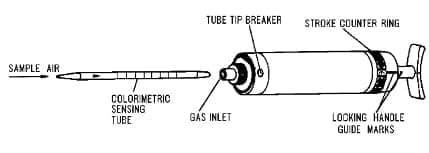
Watch out: We point out
at GAS DETECTION INSTRUMENTS - that the gas detection tube selected must be compatible with the sampling pump device used.
With each type of detector tube the manufacturer provides instructions indicating the accuracy ranges, the number of calibrated pump strokes, and the appropriate corrections to be made based on the air temperature in the measured
We usually make no correction for temperature. Higher temperatures than 68 Deg. F would justify a small upwards correction in the estimated CO level.
For example, if the tube read 500ppm and the temperature was 40degC (104degF) the actual measurement would be 55ppm. But if you're finding CO at those levels the precise number is irrelevant, and the presence of a problem is unequivocal.>
Draeger CO measuring tubes are available in sensitivity ranges from 2 to 3000 ppm or .1 % and up by volume. The bellows pump draws 100 cc of gas per stroke and can be use with a wide range of tubes. For home inspectors using the Draeger bellows pump Draeger recommends the CO 5/c detector tube to monitor CO levels between 5 and 700 ppm. Draeger tubes are a larger diameter than Gastec tubes. The two are not interchangeable.
Sensidyne pumps now use Kitagawa gas detection tubes.
As a word of caution to the client, we identify the manufacturer's claim for accuracy of the particular equipment being used. This is less accurate than the electronic digital readout equipment described earlier, but capable of identifying CO levels as low as 1 ppm.
In addition to following procedures described by the equipment manufacturer, our measurement procedure and measurement interpretation have been assisted by consulting with hazardous substance and health physicist consultants available on the SAFETY net forum. The SAFETY net forum was a special interest group organized on Compuserve, a public computer information utility.
Aspirator & Colorimetric Tube Procedure for Testing for CO, Tracer Gas, or Other Building Gases in an HVAC System
Draeger's recommendation for heating system testing includes measuring CO from the plenum as the most representative indication of CO escaping from the heat exchanger. If that area is inaccessible they suggest measuring at the closest register to the plenum.
Where to Make Gas Measurements in an HVAC System
Air samples are taken in the same locations described in Matzen's preceding article. In addition, air samples can be taken directly over the heat exchanger in a plenum by drilling a 1/4" hole.
We find or drill an opening into the heating plenum, after assuring we're drilling in a location which is certain to avoid any damage to the heat exchanger, furnace controls, or other equipment. Following testing such holes can be sealed with a snap-in button manufactured precisely for this purpose and available from heating equipment suppliers. We also seal test holes with gummed foil tape.
Watch out: do not drill holes if you don't know what you're doing: you may damage the equipment or make it unsafe.
When to make gas measurements in an HVAC Plenum: Before the Fan Runs
When measuring over the heat exchanger in a plenum we take air samples before the system operates, after the burner has operated but before the blower fan is running, and after the blower fan is running. After making a number of measurements with other instruments with the blower fan running, Tom Byrne (ASHI NY) pointed out to us that the blower pressurizes the area around the heat exchanger, making it less likely that flue gases will escape into the house air - depending on the location of any defect.
DeWerth explains this same point in
his HEAT EXCHANGER LEAK 3-STEPS article in this 1991 Journal issue.
Further,
the added volume of house air significantly dilutes gases leaking
from the heat exchanger. Thus a more proper diagnostic test
is taken with the heat exchanger hot (small cracks may have opened)
but before the fan runs.
Also see HEAT EXCHANGER LEAK TEST
Watch out: we've heard procedures suggesting disabling the blower fan and running the system "hot" (protected of course by the limit switch) in order to obtain longest test interval in the plenum. This is a very tempting procedure for users of the Gastec method since a test requiring three pump strokes may take nine minutes.
Many furnace plenums heat so rapidly that the system will not run for nine minutes without operating the fan. But in our opinion there is risk of causing damage to a marginal heat exchanger by this procedure: bringing the heat exchanger to excessive temperatures beyond those intended by the manufacturer for normal operation may cause buckling or even cracks at welded seams. Such damage can render the system unsafe or inoperable.
Therefore during normal inspection procedures we never run the furnace with the blower disabled.
Adjusting the Colorimetric Gas Sampling Tube & Pump Precision by Pump Stroke Count
The measurement range of the detector tube depends on the number of pump strokes taken. For example, with the Sensidyne pump and GasTec tube, 8-150 ppm requires three pump strokes. 25-500 ppm requires one pump stroke. 500-1000 ppm requires 1/2 pump stroke. Rather than waste tubes by starting with three, we examine the tube color after the first stroke and stop there if the CO level has run off the scale.
Equipment cost, less than the electronic devices described earlier, is balanced by a considerably longer time to make measurements, depending on the number of pump strokes required and the rate at which gas flows through the sampling tube. Typically the pump handle is pulled back and locked on a full stroke, giving a precise volume of air being pulled through the tube.
The operator then must wait for the vacuum created in the pump body to be satisfied by pulling sample air through the tube - which can take several minutes. Given the fan delay problems discussed above, this test method, when used in heating plenums is less tractable than those using the electronic sensing devices recommended by Matzen, and is slower than the electronic methods in all cases.
Recording Gas Detector Tube Results
Gas testing tube recording hint: as shown in our field photo above, we take a sharp close up photo of the colorimetric gas sampling tube display promptly after the test has been completed.
Because the colorimetric gas test tube works by chemical reaction, the color change in the tube cannot be expected to remain at a constant level as the exposed tube ages. Taking a color photograph of the tube after exposure and test are complete lets us make a permanent recording of the tube reading (500 ppm in the case shown).
Broad-Spectrum Analyzers for Gas Leak Detection
TIF 8800 Combustible Gas Detector
Perhaps the most widely used diffusion-type electronic sensor among home inspectors, the TIF 8800 is both versatile and inexpensive.
Typical cost is under $200., considerably less than the CO monitors discussed earlier and using no disposable tubes like the pump systems discussed above.
Details about two popular TIF instruments are at
- TIF 5000 GAS DETECTOR - refrigerant gas detection
- TIF 8800 GAS DETECTOR - combustible gas & CO detection
Gas Leak Detection Instrument accuracy
While wide range sensitivity to many problem gases and low cost may be a source of the popularity of this instrument, Matzen and others argue strongly that this instrument is not suitable for testing heat exchangers because its response level is rated at about 100 ppm of CO.
Remember that because the TIF 8800 works on a dispersal theory it will respond to virtually any substance miscible in air including all fuels from alcohol to gasoline, as well as simple humidity.
This response to humidity probably explains why the user may observe that the tic-rate of the TIF alarm actually falls off when moved from the (more humid) basement air into the (drier) warm air in a plenum above the heat exchanger. The air in a plenum, unless there's a (misplaced) humidifier right there, will drop to very low levels when the furnace is operating.
The manufacturer indicates that the instrument's sensitivity range is 50-1000 ppm with a one minute warm up time. -[TIF instruction manual L1-147 Rev. 9/85]
Matzen asserts: that at the worst
furnace he's seen, a ramshackle building in South Seattle, 58 ppm
was entering the living area - a level at which the TIF performance
was questionable. He adds that the majority of defective furnaces
he's studied produced readings of less than 10 ppm in living space.
- Instructions on how to make best use of the TIF 8800 to screen for combustible gases or CO are found at TIF 8800 Test procedure
- An example of field use of the TIF 8800 instrument is at TIF 8800 FIELD TEST
Carbon Monoxide Gas Articles
...
Continue reading at MEDICAL EFFECTS of CO or select a topic from the closely-related articles below, or see the complete ARTICLE INDEX.
Or see these
Recommended Articles
Suggested citation for this web page
CO DETECTION OPTIONS at InspectApedia.com - online encyclopedia of building & environmental inspection, testing, diagnosis, repair, & problem prevention advice.
Or see this
INDEX to RELATED ARTICLES: ARTICLE INDEX to GAS HAZARDS in BUILDINGS
Or use the SEARCH BOX found below to Ask a Question or Search InspectApedia
Ask a Question or Search InspectApedia
Try the search box just below, or if you prefer, post a question or comment in the Comments box below and we will respond promptly.
Search the InspectApedia website
Note: appearance of your Comment below may be delayed: if your comment contains an image, photograph, web link, or text that looks to the software as if it might be a web link, your posting will appear after it has been approved by a moderator. Apologies for the delay.
Only one image can be added per comment but you can post as many comments, and therefore images, as you like.
You will not receive a notification when a response to your question has been posted.
Please bookmark this page to make it easy for you to check back for our response.
IF above you see "Comment Form is loading comments..." then COMMENT BOX - countable.ca / bawkbox.com IS NOT WORKING.
In any case you are welcome to send an email directly to us at InspectApedia.com at editor@inspectApedia.com
We'll reply to you directly. Please help us help you by noting, in your email, the URL of the InspectApedia page where you wanted to comment.
Citations & References
In addition to any citations in the article above, a full list is available on request.
- In addition to citations & references found in this article, see the research citations given at the end of the related articles found at our suggested
CONTINUE READING or RECOMMENDED ARTICLES.
- Carson, Dunlop & Associates Ltd., 120 Carlton Street Suite 407, Toronto ON M5A 4K2. Tel: (416) 964-9415 1-800-268-7070 Email: info@carsondunlop.com. Alan Carson is a past president of ASHI, the American Society of Home Inspectors.
Thanks to Alan Carson and Bob Dunlop, for permission for InspectAPedia to use text excerpts from The HOME REFERENCE BOOK - the Encyclopedia of Homes and to use illustrations from The ILLUSTRATED HOME .
Carson Dunlop Associates provides extensive home inspection education and report writing material. In gratitude we provide links to tsome Carson Dunlop Associates products and services.


